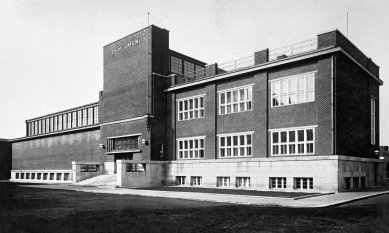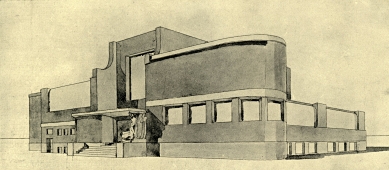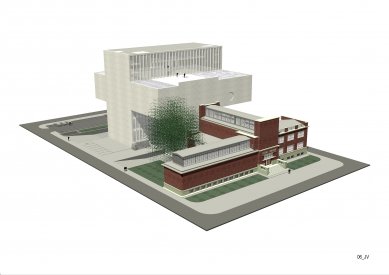
Ostrava House of Art celebrates 95 years
Source
Jana Malášek Šrubařová, GVUO
Jana Malášek Šrubařová, GVUO
Publisher
Tisková zpráva
10.05.2021 21:25
Tisková zpráva
10.05.2021 21:25
Czech Republic
Ostrava
Josef Pleskot
František Fiala
Vladimír Wallenfels
The House of Art has adorned Ostrava with beautiful architecture and a collection of art from the late 15th century to the present for 95 years. It was officially opened on May 13, 1926. On the anniversary day, the Gallery of Fine Arts in Ostrava (GVUO) will offer free admission to all exhibitions and an online program in the afternoon, starting at 5 PM with the opening of the intimate exhibition "Drawings from the Collection of František Jureček," presented by curator Gabriela Pelikánová. At 6 PM, there will be an unconventional and light-hearted online guided tour of the House of Art with director Jiří Jůza.
The House of Art is managed by the Gallery of Fine Arts in Ostrava (GVUO), which is established by the Moravian-Silesian Region. We carefully attend to the architectural heritage of the region, and thanks to our funding, the House of Art has undergone a number of necessary renovations, from cellar spaces to the renovation of parquet floors, installation of air conditioning in exhibition halls, and extensive roof reconstruction, said Lukáš Curylo, Deputy Governor of the Moravian-Silesian Region for Culture and Heritage Protection, who took patronage over the exhibition, adding that all renovation work carried out on the House of Art is always consulted with the National Heritage Institute to preserve the original form and function of the listed building.
In 1926, the House of Art was the most modern art museum in the country. Its purist appearance with large areas of brick walls reflects the period atmosphere. For its time, it was revolutionary in lighting, air conditioning, and the layout of exhibition halls. It continues to meet the significantly stricter requirements for exhibiting artworks, added Jiří Jůza, director of GVUO.
The construction of the House of Art from 1924 to 1926 was spearheaded by art lovers in Ostrava, led by the prominent builder František Jureček, who bequeathed a large part of his own collection to the Society of the House of Art. Significant contributions were also made by then-mayor Jan Prokeš, director of Vítkovice coal mines and mining company Eduard Šebela, and entrepreneur Jan Geisler. Together with other personalities and art admirer Alois Sprušil, they founded the Society for the Construction and Maintenance of the Exhibition Pavilion in Moravian Ostrava in 1923, explained Gabriela Pelikánová, curator of the drawing exhibition.
The Society announced a public architectural competition for the design of the House of Art in 1923. The jury included architects František Vahala and Bohuslav Fuchs, as well as art historian Václav Vilém Štech. Among the forty-one entries, two projects received second place. No first prize was awarded. In the anonymous competition, the design by Kamil Roškot labeled with the letters SPQ and the project by architects František Fiala and Vladimír Wallenfels marked with a red square were selected. The project with the red square was chosen for construction, which was implemented with minor modifications to the present form of the House of Art.
The House of Art stands on a plot of 2,400 m², donated to the society by the city of Ostrava. The construction lasted twenty-two months and had to be carried out on a reinforced concrete slab due to ground subsidence. This also caused the cost to rise to nearly 2.5 million crowns, which was a million more than originally intended, said Jůza, announcing that the society received financing for the construction from donations and from a loan from the Moravskoslezská Savings Bank. The loan was then repaid from the income from renting out lecture spaces and from the sale of artworks.
The House of Art was opened on May 13, 1926, with a permanent exhibition from Jureček's collection and the First Exhibition from Private Collections of Ostrava, which lasted only eleven days. During the first exhibition decade of the House of Art, ninety-nine exhibitions took place, attracting nearly ninety thousand visitors. They collected one hundred fifty thousand crowns in entrance fees and sold artworks for more than 1.5 million crowns, said Pelikánová, adding that the society kept ten percent of the sale price of each exhibited and subsequently sold artwork in agreement with the artists.
As early as 1936, during a large acquisition of the House of Art, the first director Alois Sprušil appealed for the lack of exhibition and storage spaces and the necessity of an extension. However, plans for the extension were not realized, and the space shortage is still relevant in GVUO today. The situation could be resolved by the addition of the so-called White Shadow, an architectural project by Josef Pleskot. Currently, the House of Art has only 750 m² designated for exhibition purposes. Thanks to the extension, permanent exhibitions would gain 2,150 m², and temporary exhibitions would have 1,250 m². The building would include several multifunctional halls, classrooms for schoolchildren, studios, laboratories, and a new storage space. The House of Art would become barrier-free thanks to the White Shadow, explained Jůza, continuing that the new building will be connected with the current House of Art and will become its white shadow. GVUO would thus gain new spaces for offices and a library, which are currently located in another building on Poděbradova Street. The statutory city of Ostrava, the Moravian-Silesian Region, and the Ministry of Culture of the Czech Republic have promised to co-finance the construction.
GVUO will offer free admissions to exhibitions and an online accompanying program on the anniversary of the House of Art. We wanted to hold live guided tours of the House of Art. That is currently not possible, so we recorded the tour virtually. My colleagues also participated in this, and I thank them very much for it. I hope you will enjoy it and learn a lot of new information, concluded Jůza. At 5 PM, there will be an online opening of the exhibition "Drawings from the Collection of František Jureček," presenting 13 drawings and gouaches by Czech authors from the turn of the 19th and 20th centuries, such as Mikoláš Aleš, Max Švabinský, or Jan Preisler. The light-hearted online guided tour of the House of Art with gallery director Jiří Jůza will begin at 6 PM. Both will be viewable on the GVUO's Facebook and YouTube.
The House of Art is managed by the Gallery of Fine Arts in Ostrava (GVUO), which is established by the Moravian-Silesian Region. We carefully attend to the architectural heritage of the region, and thanks to our funding, the House of Art has undergone a number of necessary renovations, from cellar spaces to the renovation of parquet floors, installation of air conditioning in exhibition halls, and extensive roof reconstruction, said Lukáš Curylo, Deputy Governor of the Moravian-Silesian Region for Culture and Heritage Protection, who took patronage over the exhibition, adding that all renovation work carried out on the House of Art is always consulted with the National Heritage Institute to preserve the original form and function of the listed building.
In 1926, the House of Art was the most modern art museum in the country. Its purist appearance with large areas of brick walls reflects the period atmosphere. For its time, it was revolutionary in lighting, air conditioning, and the layout of exhibition halls. It continues to meet the significantly stricter requirements for exhibiting artworks, added Jiří Jůza, director of GVUO.
The construction of the House of Art from 1924 to 1926 was spearheaded by art lovers in Ostrava, led by the prominent builder František Jureček, who bequeathed a large part of his own collection to the Society of the House of Art. Significant contributions were also made by then-mayor Jan Prokeš, director of Vítkovice coal mines and mining company Eduard Šebela, and entrepreneur Jan Geisler. Together with other personalities and art admirer Alois Sprušil, they founded the Society for the Construction and Maintenance of the Exhibition Pavilion in Moravian Ostrava in 1923, explained Gabriela Pelikánová, curator of the drawing exhibition.
The Society announced a public architectural competition for the design of the House of Art in 1923. The jury included architects František Vahala and Bohuslav Fuchs, as well as art historian Václav Vilém Štech. Among the forty-one entries, two projects received second place. No first prize was awarded. In the anonymous competition, the design by Kamil Roškot labeled with the letters SPQ and the project by architects František Fiala and Vladimír Wallenfels marked with a red square were selected. The project with the red square was chosen for construction, which was implemented with minor modifications to the present form of the House of Art.
The House of Art stands on a plot of 2,400 m², donated to the society by the city of Ostrava. The construction lasted twenty-two months and had to be carried out on a reinforced concrete slab due to ground subsidence. This also caused the cost to rise to nearly 2.5 million crowns, which was a million more than originally intended, said Jůza, announcing that the society received financing for the construction from donations and from a loan from the Moravskoslezská Savings Bank. The loan was then repaid from the income from renting out lecture spaces and from the sale of artworks.
The House of Art was opened on May 13, 1926, with a permanent exhibition from Jureček's collection and the First Exhibition from Private Collections of Ostrava, which lasted only eleven days. During the first exhibition decade of the House of Art, ninety-nine exhibitions took place, attracting nearly ninety thousand visitors. They collected one hundred fifty thousand crowns in entrance fees and sold artworks for more than 1.5 million crowns, said Pelikánová, adding that the society kept ten percent of the sale price of each exhibited and subsequently sold artwork in agreement with the artists.
As early as 1936, during a large acquisition of the House of Art, the first director Alois Sprušil appealed for the lack of exhibition and storage spaces and the necessity of an extension. However, plans for the extension were not realized, and the space shortage is still relevant in GVUO today. The situation could be resolved by the addition of the so-called White Shadow, an architectural project by Josef Pleskot. Currently, the House of Art has only 750 m² designated for exhibition purposes. Thanks to the extension, permanent exhibitions would gain 2,150 m², and temporary exhibitions would have 1,250 m². The building would include several multifunctional halls, classrooms for schoolchildren, studios, laboratories, and a new storage space. The House of Art would become barrier-free thanks to the White Shadow, explained Jůza, continuing that the new building will be connected with the current House of Art and will become its white shadow. GVUO would thus gain new spaces for offices and a library, which are currently located in another building on Poděbradova Street. The statutory city of Ostrava, the Moravian-Silesian Region, and the Ministry of Culture of the Czech Republic have promised to co-finance the construction.
GVUO will offer free admissions to exhibitions and an online accompanying program on the anniversary of the House of Art. We wanted to hold live guided tours of the House of Art. That is currently not possible, so we recorded the tour virtually. My colleagues also participated in this, and I thank them very much for it. I hope you will enjoy it and learn a lot of new information, concluded Jůza. At 5 PM, there will be an online opening of the exhibition "Drawings from the Collection of František Jureček," presenting 13 drawings and gouaches by Czech authors from the turn of the 19th and 20th centuries, such as Mikoláš Aleš, Max Švabinský, or Jan Preisler. The light-hearted online guided tour of the House of Art with gallery director Jiří Jůza will begin at 6 PM. Both will be viewable on the GVUO's Facebook and YouTube.
The English translation is powered by AI tool. Switch to Czech to view the original text source.














